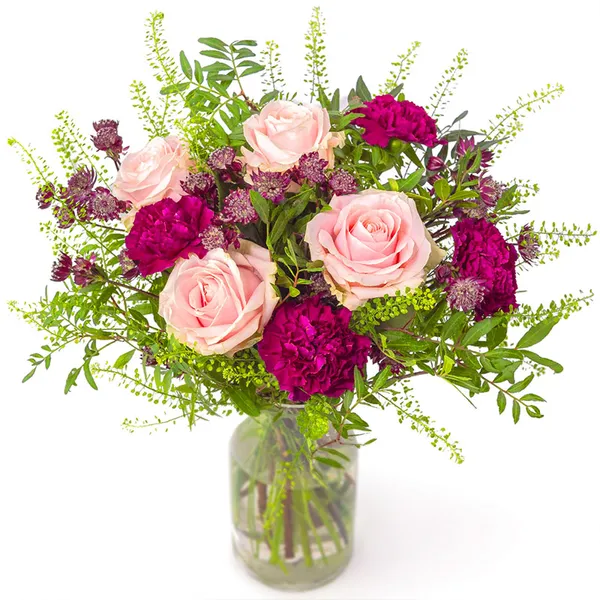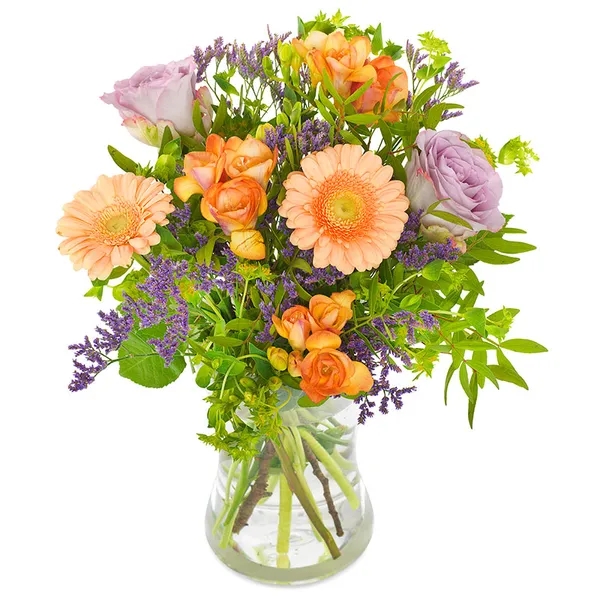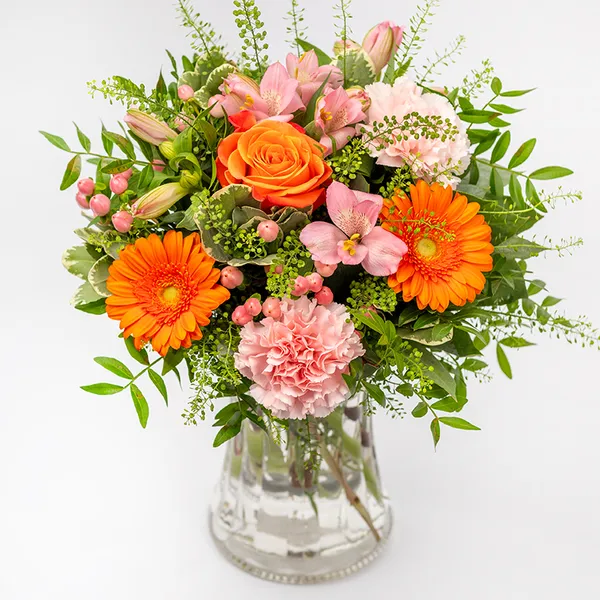Gladiolus: The Majestic and Striking Bloom
Gladioli are tall, elegant flowers known for their striking, sword-shaped leaves and vibrant, trumpet-like blooms that grow in vertical spikes. They symbolize strength, integrity, and remembrance, making them a popular choice for formal arrangements, sympathy bouquets, and garden displays. Originating from Africa, the Mediterranean, and parts of Asia, gladioli come in a wide range of colors, including red, pink, orange, yellow, purple, and white. Their dramatic height and colorful presence make them a favorite for adding structure and vibrancy to floral designs.
COMMON NAME
Gladiolus
BOTANICAL NAME
Gladiolus spp.
ORIGIN
Africa, Mediterranean, Asia
PEOPLE ALSO CALL IT
Sword Lily
FLOWERING TIME
Summer to early fall (July to September)
ASPECT
Full sun
SYMBOLISM
Strength, integrity, honor, remembrance, infatuation
Care Tips for Cut Gladioli in a Vase
Cut at the Right Stage: Harvest gladioli when the bottom two to three flowers on the spike are open, while the upper buds are still closed.
Trim Stems at an Angle: Re-cut the stems diagonally before placing them in water to improve water absorption.
Use Tall Vases: Gladioli are tall flowers that need a sturdy vase for proper support.
Remove Lower Leaves: Strip any leaves that would sit below the waterline to prevent bacteria growth.
Change Water Regularly: Refresh the water every two days and use floral preservative to extend bloom life.
Keep in a Cool Spot: Place the vase in a cool location, away from direct sunlight and drafts, to prolong the flowers' lifespan.
Symbolism & Meaning
Gladioli symbolize strength, integrity, and perseverance due to their upright growth and towering presence. In some cultures, they also represent infatuation, as their sword-like shape was historically linked to the phrase "piercing the heart with love." Gladioli are commonly used in sympathy arrangements to honor loved ones, as well as in celebrations of personal achievement and resilience.
Types of Gladioli
Gladioli come in a variety of forms and sizes, with Grandiflora Gladioli being the most popular, known for their large, showy blooms arranged along tall spikes. Nanus Gladioli are shorter and more compact, making them ideal for smaller gardens and pots. Butterfly Gladioli feature ruffled, delicately patterned petals, adding a softer, more whimsical look to floral displays. With their bold colors and vertical elegance, gladioli are a stunning addition to gardens and arrangements alike.
Frequently Asked Questions About Gladioli
Gladioli bulbs (technically corms) should be planted in spring, once the danger of frost has passed and the soil has warmed to at least 10°C.
In most climates, this means planting from March to May, depending on the region.
To enjoy continuous blooms throughout the summer, stagger plantings every 2 weeks until early summer.
Gladioli bloom approximately 70-100 days after planting, depending on the variety and climate.
If planted in spring (April-May), they will typically flower between July and September.
By staggering the planting every two weeks, you can extend the blooming period for several months.
- Choose the right location: Gladioli thrive in full sun (at least 6 hours per day) and well-drained soil.
- Prepare the soil: Loosen the soil and mix in compost or organic matter for better drainage and nutrients.
- Planting depth and spacing: Plant corms 10-15 cm deep with the pointed end facing upward. Space them 15-20 cm apart to allow proper airflow and growth.
- Watering:Water thoroughly after planting and keep the soil evenly moist but not soggy.
- Support taller varieties: Some gladioli varieties can grow 120 cm tall, so staking may be needed to prevent them from bending.
In warm climates, gladioli are perennials and can be left in the ground year-round.
In colder climates, gladioli corms do not survive winter and must be dug up and stored indoors to be replanted the following year.
Some smaller or wild varieties of gladiolus (e.g., Gladiolus nanus) are more cold-hardy and may survive mild winters.
- Yes, gladioli are toxic to cats if ingested. The corms (bulbs) and flowers contain toxic compounds that can cause:
- Vomiting
- Drooling
- Lethargy
- Diarrhea
- If a cat eats gladiolus flowers or corms, consult a veterinarian immediately.
In cold climates (zones 3-7), gladioli corms should be dug up in autumn, usually 4-6 weeks after flowering, when the leaves turn yellow.
- How to lift and store gladiolus corms:
- Cut back the foliage to 5-7 cm above the corm.
- Carefully dig up the corms with a fork, shaking off excess soil.
- Allow them to dry in a warm, well-ventilated place for 1-2 weeks.
- Remove and discard old, shriveled corms (new corms form on top).
- Store the healthy corms in a cool, dry, frost-free place (2-7°C), ideally in a paper bag or mesh sack.
Deadhead spent flowers: Once the flowers fade, remove the flower spikes to redirect energy to the corm.
Keep the foliage: Allow the leaves to remain until they turn yellow, as they continue to nourish the corm for the next season.
Water less frequently: Reduce watering after flowering to allow the plant to enter dormancy.
In warm climates: Simply leave the corms in the ground to rebloom next year.
In cold climates: Dig up the corms (read more in the next question).



